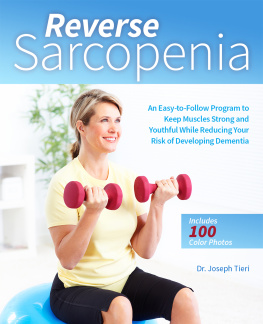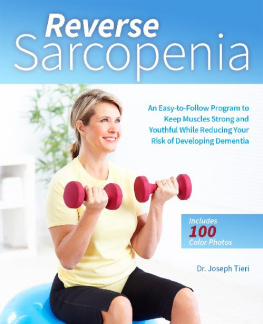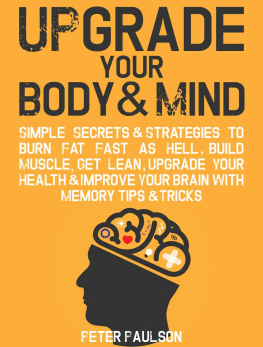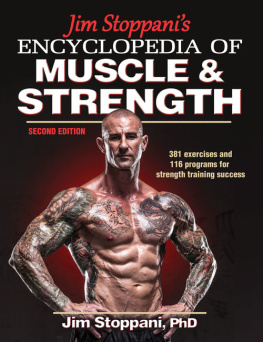
Reverse
Sarcopenia
An Easy-to-Follow Program to Keep Muscles Strong and Youthful While Reducing Your Risk of Developing Dementia
Dr. Joseph Tieri

Text copyright 2019 Joseph Tieri. Design and concept 2019 Ulysses Press and its licensors. Photographs copyright 2019 Rapt Productions except as noted below. All rights reserved. Any unauthorized duplication in whole or in part or dissemination of this edition by any means (including but not limited to photocopying, electronic devices, digital versions, and the internet) will be prosecuted to the fullest extent of the law.
Published in the United States by:
Ulysses Press
P.O. Box 3440
Berkeley, CA 94703
www.ulyssespress.com
ISBN13: 978-1-61243-918-1
Acquisitions editor: Bridget Thoreson
Managing editor: Claire Chun
Editors: Lily Chou, Lauren Harrison
Proofreader: Barbara Schultz
Indexer: Sayre Van Young
Front cover design: what!design @ whatweb.com
Photos: Rapt Productions except cover kurhan/
Production: Jake Flaherty
Models: Alex Lewin, Kym Sterner
Please note: This book has been written and published strictly for informational purposes, and in no way should be used as a substitute for consultation with healthcare professionals. You should not consider educational material herein to be the practice of medicine or to replace consultation with a physician or other medical practitioner. The author and publisher are providing you with information in this work so that you can have the knowledge and can choose, at your own risk, to act on that knowledge. The author and publisher also urge all readers to be aware of their health status and to consult healthcare professionals before beginning any health program.
For my loving wife, Janice, and my adorable and precious daughters, Lexi and Madie.
Contents
Introduction
[sarcopenia] is an independent predictor of all-cause mortality and cognitive impairment, increasing the chances of institutionalization later in life.
Alex Han and Steven L. Bokshan, et al., in the Journal of Clinical Medicine
Believe it or not, by the time you reach the ripe young age of 50, your muscleswhich have already been getting weaker for more than a decadealso begin to thin and can lose up to 1 percent of their strength every year. This age-related muscle loss and weakness is called sarcopenia. The disease, along with its consequences, is one of the hottest topics in medicine.
Studies are now revealing that these age-related changes in the muscles create and accompany many more health problems than previously thought, including balance issues that lead to falls, osteoporosis, fractures, and an increased incidence of dementia. The abnormalities that occur in sarcopenia are accompanied by other physiologic changes, resulting in a host of additional medical illnesses, post-surgical complications, and, at a certain point, an increased risk of dying from all conditions!
Fortunately, new information is emerging about strategies to combat the disease. The most important is a simple form of exercise called progressive resistance. While its more popular among younger gym-goers, progressive resistance exercise (PRE) is well-tolerated and extremely beneficial to adults, even very elderly and frail people. PRE not only slows the progression of sarcopenia, but also reverses and prevents it. Nutritional interventions, especially adequate protein intake, are also showing promise in combating sarcopenia.
Simply put, modern science is learning just how common and debilitating aging muscles can be on the quality and quantity of life, and how effective the right interventions are to keep them strong and healthy. With a little effort, the ability to maintainor return toa healthier state, keep physical function and mental capacity intact, and live independently long into your senior years can be a reality. Without it, those things are in serious jeopardy.
Prevalence
Sarcopenia is a widespread public health problem. Though estimates vary, approximately a quarter of people in their 60s already have substantial muscle loss and signs of weakness, and once into their 70s, more than 40 percent of people will have sarcopenia. The problem currently affects more than 50 million older men and women worldwide, and that number is expected to surge to 500 million adults in the next few decades. Its also a costly problem, with more than $20 billion spent each year in the United States on the consequences of the disease.
It begins as early as in ones late 30s. The loss of strength and power happens slowly, declining about 3 to 5 percent per decade. It accelerates to 5 to 10 percent loss per decade as adults reach their 50s, 10 to 15 percent during their 60s, and by the time older adults advance into their 70s, a staggering 25 to 40 percent loss of strength and a 15 percent loss of muscle mass per decade can occur. All totaled, sarcopenia can add up to more than 30 percent muscle loss over a lifetime.
History
The weakness that accompanies aging is nothing new. Marcus Tullius Cicero, a Roman statesman and philosopher, wrote about it in a treatise on old age in 44 B.C. While many lamented the decay of old age, Cicero realized that much could be done about it, advising that it was our duty to fight against it as we would fight against disease; to adopt a regimen of health; to practice moderate exercise. And while Cicero was right that it is our duty to fight the symptoms of old age, our understanding of this ancient condition has only recently grownbetter equipping us for the battle!
While officially coined in 1989, the term sarcopeniafrom the Greek for poverty of the fleshhas newly achieved some uniform diagnostic consensus. Many experts now agree that sarcopenia should include both the signs of age-related muscle loss as well as the symptoms of getting weakerof functional decline. This collective agreement has resulted in a flurry of new research just in the past decade. While challenges still exist in accurately diagnosing individuals, and there is still a lot to learn in tailoring interventions, the wealth of new information has better defined the condition and brought forth new solutions.
Patient Experiences with Weakness
I frequently observe this in my office: My 50-year-old patients are a little slow to get up from the chair; the 60-year-olds use their arms as they muster more effort to get their legs under them when they rise; and my 70- and 80-year-olds make slight grunting sounds and struggle to gain their balance, slow and unsteady as they begin to walk.
Difficulty getting up from a chair is the tip of the iceberg. My older patients also report problems getting out of cars and climbing stairs, lifting grandchildren and grocery bags, and opening windows and jars. These inconveniences together compromise the ability to perform activities of daily living, or ADLs. Along with the cognitive decline associated with sarcopenia, more and more assistance becomes necessary, and, to the dismay of patients and families alike, independent living is easily lost and nursing home admissions often follow.
Like many physicians, I used to think this weakness was unavoidablejust a normal part of the aging process. And yet, through my clinical experience treating older patients, I have come to know that many of the chronic muscle and joint problemsalso believed to be an inevitable aspect of agingcan often be reversed and prevented. Fortunately, the same is true with muscle loss and weakness. Unfortunately, most adults are not doing nearly enough to get stronger and prevent sarcopenia, even those that lead active lives.
Next page













